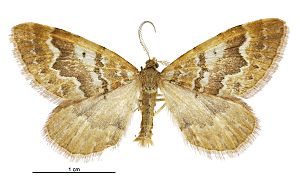Asaphodes exoriens facts for kids
Quick facts for kids Asaphodes exoriens |
|
|---|---|
 |
|
| Male | |
| Scientific classification | |
| Synonyms | |
|
Asaphodes exoriens is a species of moth in the family Geometridae. This species is endemic to New Zealand.
Contents
Taxonomy
This species was described by Louis Beethoven Prout in 1912 as Larentia exoriens using material collected by George Howes at Glenorchy in Otago in March. George Hudson discussed and illustrated this species under the name Xanthorhoe exoriens in his 1928 publication The Butterflies and Moths of New Zealand.
In 1987 Robin C. Craw proposed assigning this species to the genus Asaphodes. In 1988 John S. Dugdale agreed with this proposal. The holotype specimen is held at the Natural History Museum, London.
Description
Hudson described the species as follows:
The expansion of the wings is 1+1⁄8 inches. All the wings are ochreous, the forewings being strongly tinged with reddish on the costa and extreme base; the median band consists of four very irregular faint blackish lines, the second and third lines forming three distinct loops; there is a distinct blackish discal dot and the outer edge of the median band is very strongly waved, with distinct projections above and below the middle; the subterminal area is broad with one or two very faint cloudy marks; all the wings have a terminal series of minute brown marks, and all the cilia are plain ochreous without bars. The underside of the hind-wings is dull reddish-ochreous without bars. The underside of the hind-wings is dull reddish-ochreous without distinct markings.
Distribution
This species is endemic to New Zealand. It has only been found in Central Otago.
Biology and life cycle
A. exoriens is on the wing in March.
Habitat and host species
A. exoriens is an alpine species that frequents open grassy habitat. The adult moths are found in upland wetland habitat at altitudes of between 800-1100m.
Images for kids


